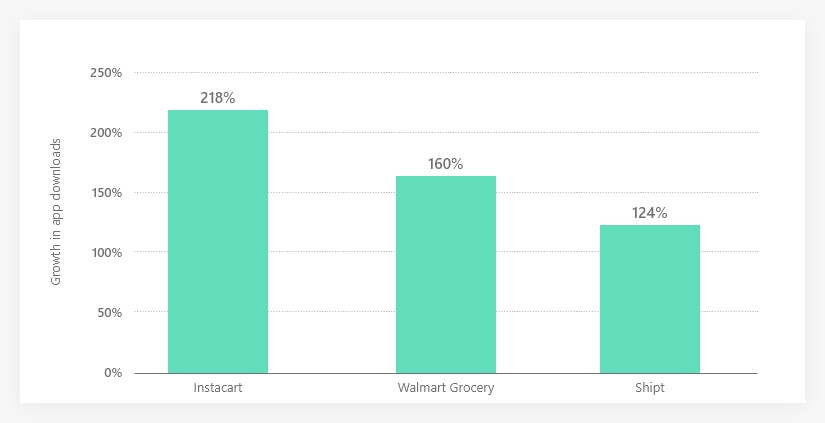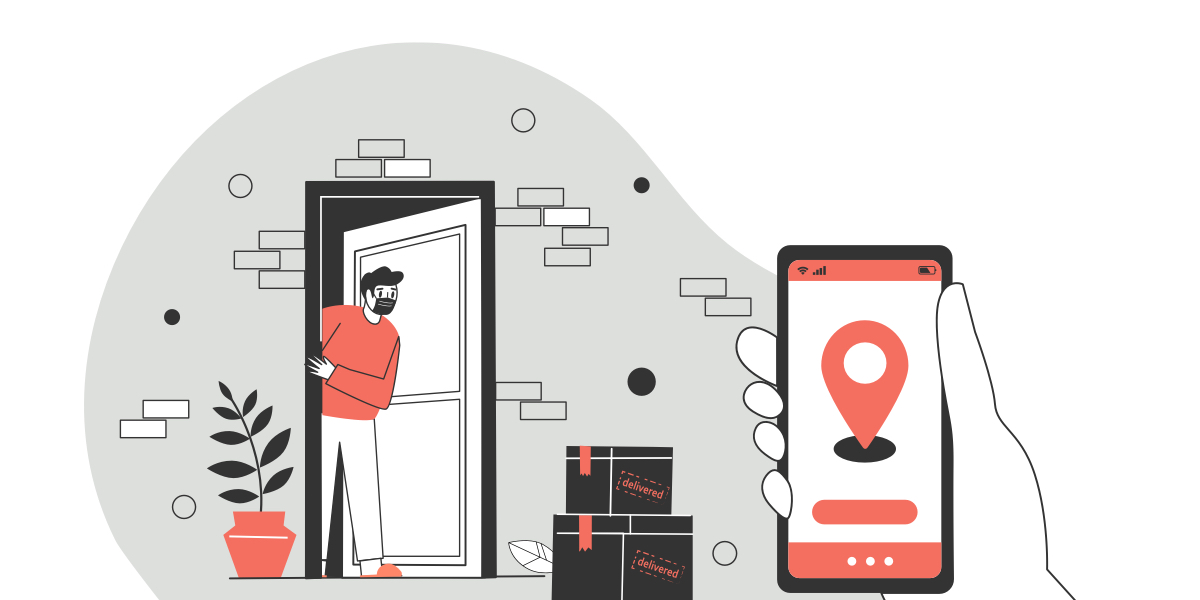The COVID-19 pandemic has changed the way businesses operate worldwide. One can assume that it will go on to be the defining moment of 2020.
Where some countries and industries are experiencing a drop in sales, others are finding success during current uncertain times. E-commerce sector, for example, that is seeing a surge in revenue and profit.
Online shopping was a preferred option for millennials. But the fear of Coronavirus and social distancing has enticed even Generation X and Baby Boomers to turn to the web for their daily necessities.
On-demand delivery businesses, in particular, are witnessing exponential growth in sales as countries experience lockdown. According to Google Trends, there has been an unprecedented rise in the adoption of online grocery shopping in recent months than in 2019.
That said, what's the reason for the rise in on-demand grocery apps, and how do they benefit businesses around the globe?
The blog highlights some factors responsible for the popularity of grocery delivery apps, how they benefit users, and their top features. We'll also discuss the cost of developing an on-demand delivery app, should you decide by the end to create an app for your business.
The Rise in the Popularity of Grocery Apps
The spread of COVID-19 has made life difficult for individuals and businesses alike. Everyone is looking for a silver lining to these dark times. On-demand mobile apps are the solution that makes our lives a little bit easier during the lockdown.
Walmart, Instacart, and Shipt are examples of e-commerce businesses that have seen a surge in app downloads since January 2020. According to reports, global app downloads almost hit 106 million downloads between March 29 and April 4, 2020.
The U.S. alone was responsible for up to 14.4 million downloads that is a 20% increase within the same timeframe. Walmart Grocery climbed 460% higher, whereas Amazon witnessed a 20% increase in average daily downloads since January.

That said, here are some benefits that on-demand delivery apps offer, in light of the global pandemic:
Social Distancing and Lockdown
Government officials around the world are strictly enforcing lockdown as the spread of Coronavirus worsens by the day. So, not only are malls and stores closed down for business, social distancing makes it challenging for people to shop for their daily necessities.
That said, individuals are forced to turn to online solutions for their daily essentials, including grocery items. On-demand grocery apps make life convenient, allowing people to get what they need without leaving their homes and endangering their lives or others.
Swift Service
One of the significant perks of on-demand apps is their instant service. During the COVID-19 pandemic, they have stepped up to meet the needs of consumers. They ensure the swift delivery of goods, earning them users' trust and boosting user acquisition and retention rates.
Additionally, on-demand apps provide other features within regulations of the current pandemic. Food delivery apps ensure the restaurants follow all WHO cleanliness guidelines, offer contactless delivery, and more. Grocery apps, on the other hand, help people get essential ingredients they need to make a decent meal, without leaving their homes.
Secure and Contactless Payment & Delivery
Another advantage of using on-demand grocery apps is that they offer in-app payment options, allowing users to pay virtually. Plus, with PayPal and Stripe integration, for example, they guarantee secure transactions.
Virtual transactions not only eliminate the physical exchange of money but also cut off the need for people to rush outside and withdraw cash from ATMs. It promotes social distancing, ensuring individuals get what they need during the lockdown.
Benefits of Multi-Delivery App
It's not just average citizens that can reap the benefits of on-demand grocery apps. For business owners, they open opportunities to earn profits despite the economic downturn during the COVID-19 pandemic.
With nationwide lockdowns, quarantine, and travel bans, most cities have come to a complete standstill. It's crippled the corporate sector, pushing back the global economy by several decades.
Technology, however, once again proves how it can benefit not just average citizens, but also business owners. Whether you run a grocery shop or have an idea for an online startup, on-demand grocery app development can help you boost customer acquisition and sales.
Here are some advantages entrepreneurs gain by developing on-demand grocery apps:
Customer Satisfaction
With on-demand grocery delivery, users can get their daily essentials without needing to step outside their homes. It eliminates their fear of the pandemic and limits its spread.
Plus, the digital platform features an extensive inventory that provides users a variety of pantry items and cooking supplies in place. It boosts customer satisfaction rating as users can continue a life of ease despite the COVID-19 pandemic.
That said, businesses can also experience a rise in customer acquisition and retention rates.
Delivery Through Bots or Drones
Companies across the world are adopting different delivery techniques to stop the spread of Corona. One such option is using bots or drones. They can drop off goods at people's homes, eliminating physical contact between people.
Using alternative modes of delivery can help businesses deliver goods to various areas around the city. Not only can customers breathe easily and avoid physical contact with the delivery person, but companies increase their sales by providing attractive offers with their services.
Increased Revenue for Business Owners
With everything on lockdown and social distancing a necessity, the need for on-demand service apps is skyrocketing. For businesses, the greater the demand, the higher are their chances of earning more.
Consumers can live their life conveniently, while companies continue operations and rake in higher revenue, despite the economic downturn.
That said, it is also an excellent startup opportunity for entrepreneurs. A global recession offers startups certain advantages over other businesses that help them survive the current pandemic and be successful in the years to come.
Top Features of Grocery Mobile Apps
We've covered the benefits of on-demand grocery apps, so let's look at some features to include for a successful delivery mobile app.
With the uncertainty surrounding the global pandemic, there's no telling when we'll be free to roam the malls freely. An app's features and functionality are what set you apart from your competitors. Meaning, you need to ensure your app has some of these basic functionalities and more:
Search Filters or Smart Search Options
An online shopping app is bound to have a thousand dozen products and multiple categories for users to browse. For a grocery app, it includes raw produce to frozen meat, fish, dairy items, cooking oil, and more.
Subsequently, online shopping needs to promote convenience. If users need to search through an extensive inventory to find one product, they are likely to delete the app and switch to a competitor.
Search filters make it easy to find one item or items that users need. You can also integrate smart search options like voice-optimized searches, featured, and recommended lists.
Multiple Payment Options
One advantage of online shopping is multiple payment options, including cash on delivery, internet transactions, and third-party payment gateways.
After filling up their cart with necessities, all they want is to check out quickly and receive their products. That said, your on-demand grocery delivery app needs to offer multiple secure payment gateways for users to shop and pay directly from the app.
From PayPal, GPay, online banking, debit/credit cards, to cash on delivery, offer your users the choice to choose any payment method they prefer. It will also help build trust among your target audience, which will impact your customer retention rate.
Real-Time Tracking Feature
Real-time tracking is a must for any on-demand service app. It helps users track the rider from the moment they place their order to the time it arrives at their doorstep.
With a tracking feature in your grocery app, users can monitor the status of their orders. From when it is dispatched, its estimated time of delivery, to when they receive it, it will ensure complete transparency.
Wish List
A wish list is where users can save items for future purchase. With recommended and featured lists, you can also provide your users with the option to curate their wish list within your grocery delivery app.
Innovations in technology allow you to provide options like add a reminder so users can receive notifications alerting them of the items left in their list. You can also enable them to share their curated lists with family and friends as needed.
In-App Communication
The in-app chat feature allows users to contact the riders and get an estimate of how long it will take to deliver. Open communication eliminates discrepancies; plus, it enables delivery persons to get in touch with users if they have trouble finding the destination.
Push Notifications
Push notifications help businesses increase app engagement and alert users about ongoing deals and sales. You can also encourage users to complete the purchase of items left in their cart, send recommendations, share price drop announcements for their searched products, and more.
Used wisely, push notifications can be immensely beneficial for businesses to boost their ROI in terms of user engagement, customer retention, and sales.
Email/Social Login
Along with multiple payment options, your on-demand grocery app should also support email and social media login features.
An on-demand service app usually asks users to create an account before they can use it. Social media login allows customers to access app features without needing to create an entirely new account.
It's not only convenient for users but also provides businesses the information they need from their customers.
Virtual Cart
A virtual cart, much like the shopping cart in brick and mortar stores, is where users place all items on their list. For an on-demand grocery app, a virtual cart feature is a must. Allow your users to add to their cart, edit to remove any product, or change its quantity, before proceeding to checkout.
Cost of Developing an On-Demand Grocery App
For any app, development costs depend on its features, platform, and whether you choose a full-cycle development company or a freelance developer.
Here's how each factor will influence the cost of your on-demand grocery app:
Platforms (Android, iOS, or Both)
Android and iOS are two major platforms for mobile app development, and they both have a separate set of requirements, which means varying costs. Generally, iOS apps are relatively more affordable than Android apps.
Furthermore, developing cross-platform apps means double the price. So, unless your target market includes both Android and iOS users, it's best to stick to one platform.
The platform costs typically range from $5000 for Android or iOS app development and $8,750 for hybrid apps.
Features of Your On-Demand Delivery App
Features are the deciding factor that determines the total cost of your app. For an on-demand grocery app, primary app functions include user profiles, sign up, map integration, communication, and payment options.
Sign Up, and Login feature can be simple email registration or social media login. Alternatively, you could opt for two-step verification, which would cost up to $4,000. Email sign up, on the other hand, costs up to $2,000, whereas login via social accounts comes at a charge of $3,000.
Furthermore, User Profile rates depend on the level of personalization and complexity. Simple profiles not only help manage development costs but also ensure your app is lightweight and battery-friendly. They can cost $4,000 and allow users to set up emails, pictures, birthdays, addresses, minus interaction with other users. Alternatively, complex profiles cost up to $7,000.
Map Integration, Geolocation, and Geofencing is an essential feature for an on-demand delivery service, particularly real-time tracking. For $15,000, you get map integration with notification for devices, and an accurate estimate of distance.
Unlike social platforms, your app doesn't need group chat, location sharing, voice, or video call features. So, if you aim to provide In-App Communication, you need a simple live text chat feature that includes online text messaging and push notifications for $14,000.
Payment Options depend on the tech stack of your app, target consumers, and business goals. At the cost of $7,000, your choices include storing card data directly, existing mobile POS, payment widgets like PayPal and Stripe, or a gateway API.
Additional Features
Aside from primary app functions, you can integrate additional features to improve the customer experience of your app. Rating and reviews, push notifications, search, and e-commerce are some examples of other features to enrich your on-demand grocery app.
Rating and Reviews will allow users to rate your products and services, and leave feedback on what they found best or what can be amended. For $5,000, you can learn from the users' experience with your app and improve your services.
If you aim to alert your customers of any new announcements, sales, and discounts, Push Notifications are the way to go. The feature costs $3,000 and can help you boost user engagement.
E-Commerce is the feature that provides the ability to curate menus for products and a virtual shopping cart, including email-confirmation, checkout, and online transactions. It costs up to $16,000.
Other additional features include smart search, Q.R. scanner, and coupons, as well as a calendar integration. Their costs vary from $3,000, $5,000 to $4,000, respectively.
With a smart search, you can enable your users to browse your inventory via voice search. A Calendar would allow them to schedule next month's grocery shopping and set reminders to ensure they don't forget. Similarly, QR coupons will help them get discounts and shop at budget-friendly prices.
Development Company or Freelance Developer
Your choice of a development company or freelancer plays a significant role in the total cost of app development.
With freelancers, you'll get variable rates depending on the region. For example, a specialist designer in the U.S. and Canada may charge $53 per hour, but in Western Europe and the U.K., hourly rates start at $36.
Contrarily, with a full-cycle development firm, you get a fixed price chart for working hours spend on your app. Plus, it also ensures a robust and agile development without any hidden costs. On average, an agency can charge up to $75 per hour or $3,000 per week for complex projects.
Find the Right Development Company to Help You in Your Venture
With the benefits of on-demand grocery apps during the COVID-19 pandemic, your app development method holds significant weight.
At Cubix, you are guaranteed a smooth working experience. Our team of experts do more than meet your requirements; they provide professional insights to help you work out the kinks in your ideas and bring value to the table.
So, if you want to invest in an on-demand grocery app for your business, get in touch with our experts and boost your revenue despite the current economic downturn!

